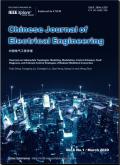Black-box Modeling of Converters in Renewable Energy Systems for EMC Assessment: Overview and Discussion of Available Models
Q1 Engineering
引用次数: 3
Abstract
The development of renewable energy systems interfaced with the grid by power electronic converters leads to increasing issues of electromagnetic coexistence between power and communication lines, as well as severe power quality issues, such as total harmonic distortion at the consumer side. Therefore, high-frequency modeling of renewable energy systems is of great importance to guide the design and development of distribution networks involving renewable sources. Owing to system complexity, black-box modeling approaches offer more advantages than traditional circuit modeling, as far as electromagnetic compatibility (EMC) analysis and filter design are the targets. In this study, different black-box modeling techniques for power converters are introduced and systematically analyzed. First, the general theory of black-box modeling is explained. Subsequently, three different modeling approaches are compared in terms of accuracy and the required experimental setup. Finally, the possible limitations of black-box modeling of power converters are investigated and discussed.用于电磁兼容评估的可再生能源系统变流器黑盒建模:综述与讨论
通过电力电子变流器与电网接口的可再生能源系统的发展导致电力和通信线路之间的电磁共存问题日益增加,以及严重的电能质量问题,例如消费者端的总谐波失真。因此,可再生能源系统的高频建模对于指导涉及可再生能源的配电网的设计和开发具有重要意义。由于系统的复杂性,就电磁兼容性分析和滤波器设计而言,黑盒建模方法比传统的电路建模方法更具优势。本文介绍并系统分析了各种变换器的黑盒建模技术。首先,阐述了黑盒建模的一般理论。随后,比较了三种不同的建模方法的精度和所需的实验设置。最后,对功率变换器黑盒建模可能存在的局限性进行了研究和讨论。
本文章由计算机程序翻译,如有差异,请以英文原文为准。
求助全文
约1分钟内获得全文
求助全文
来源期刊

Chinese Journal of Electrical Engineering
Energy-Energy Engineering and Power Technology
CiteScore
7.80
自引率
0.00%
发文量
621
审稿时长
12 weeks
 求助内容:
求助内容: 应助结果提醒方式:
应助结果提醒方式:


